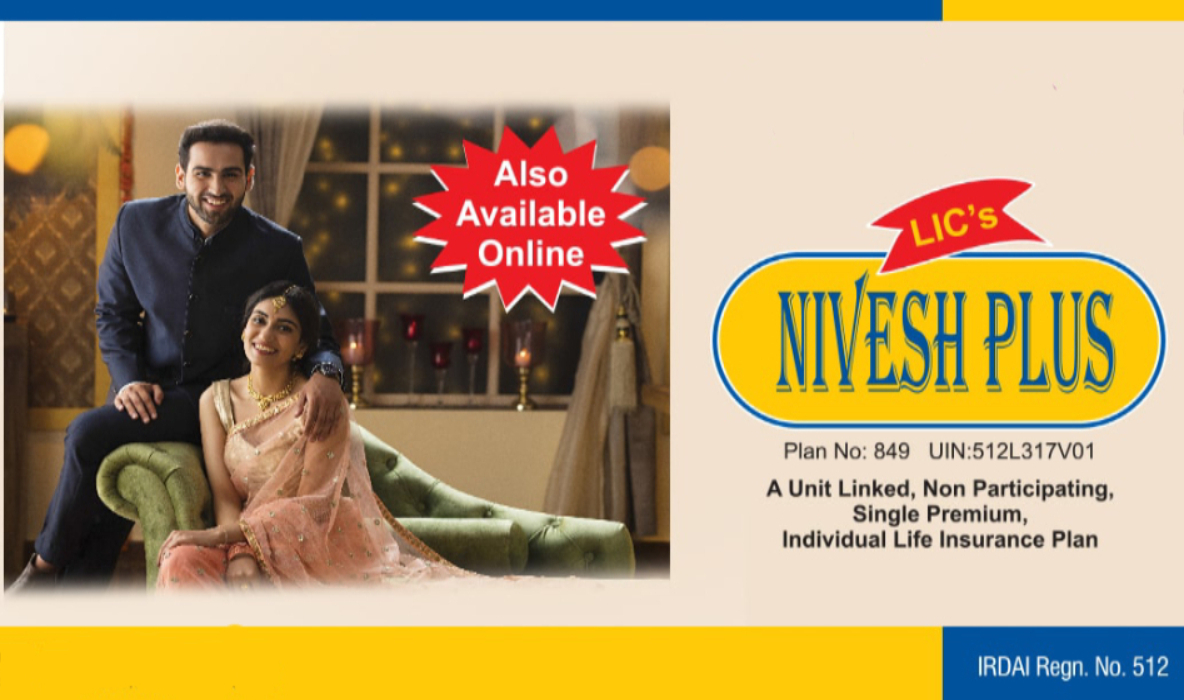Features
“IN THIS POLICY, THE INVESTMENT RISK IN INVESTMENT PORTFOLIO IS BORNE BY THE POLICYHOLDER”
LIC’s Child Fortune Plus is a unit linked plan which offers you a solution to meet your child’s educational and other needs. You can insure yourself under this plan if you are the parent of a child upto the age of 17 years last birthday in case of single premium policies and age of 10 years last birthday in case of regular premium policies. The child named under the policy shall be the nominee. There will not be any insurance coverage on the life of the child, but the policy will be allowed based on the age of the child. The policy will continue till the child attains the age of 25 years last birthday or till you (life assured) attain the age of 75 years nearest birthday, whichever is earlier.
You can pay the premiums either in lump sum (single premium) or regularly throughout policy term. The death benefit under the policy shall be the Sum Assured. You can choose the level of cover (Sum Assured) within the limits, which will depend on whether the policy is a Single premium or Regular premium contract, your age and the amount of premium you agree to pay. In addition, for regular premium policies, in case of death of the life assured during the term of the policy, the plan also provides for waiver of all future premiums including outstanding premiums, if any, provided life cover is in force.
You will also have an option to make additional investments under the policy through Top-up premiums.
Four types of investment Funds are offered. Premiums paid after allocation charge will purchase units of the Fund type chosen. The Unit Fund is subject to various charges and value of units may increase or decrease, depending on the Net Asset Value (NAV).
1. Payment of Premiums: You may pay premiums regularly at yearly, half-yearly, quarterly or monthly (through ECS mode only) intervals over the term of the policy. Alternatively, a Single premium can be paid .
2. Eligibility Conditions and Other Restrictions:
| (a) | Minimum Age at entry for Life Assured | 18 years (age last birthday) |
| (b) | Maximum Age at entry for Life Assured | 55 years (age nearer birthday) |
| (c) | Minimum Age at entry for child – | 0 years (age last birthday) |
| (d) | Maximum Age at entry for child – Regular premium: Single premium: |
[10] last birthday [17] last birthday |
| (e) | Maximum Maturity Age – | [25] last birthday of child or [75] nearest birthday of life assured, whichever is earlier |
| (f) | Policy Term – | (25 – age last birthday at entry of life assured’s child) or (75 – age nearest birthday at entry of life assured), whichever is lower |
| (g) | Minimum Premium – | Regular Premium Policies (other than monthly (ECS) mode): Rs. [10,000] p.a Regular premium (for monthly (ECS) mode): Rs. [1,000] p.m Single Premium Policies: Rs. [40,000] p.a. (h) Sum Assured – Single Premium : Minimum Sum assured : 1.25 times the single premium. Maximum Sum assured : 5 times of the single premium if age at entry is upto 35 years 2.5 times of the single premium if age at entry is from 36 to 45 years 1.25 times of the single premium if age at entry is 46 years and above Regular Premium : Minimum Sum assured : 5 times the annualised premium. Maximum Sum assured : 25 times of the annualized premium if age at entry is upto 45 years 15 times of the annualized premium if age at entry is 46 years and above Where the minimum Sum Assured is not in the multiples of Rs. 5,000, it will be rounded off to the next multiple of Rs. 5,000. Annualized Premiums shall be payable in multiple of Rs. 1,000 for other than ECS monthly. For monthly (ECS), the premium shall in multiples of Rs. 250/-. |
3. Other Features:
- » Top-up (Additional Premium): You can pay Top-up premium in multiples of Rs.1,000/- at anytime during the term of the policy without increasing the sum assured. In case of yearly, half-yearly, quarterly or monthly (ECS) mode of premium payment such Top-up can be paid only if all due premiums have been paid under the policy. At any point of time, the total of top-up premiums payable cannot exceed 25% of total amount of regular premiums paid up to that date or single premium paid.
- » Partial Withdrawals: Youmay encash the units partially after the third policy anniversary subject to the following:
- » Partial withdrawals may be in the form of fixed amount or in the form of fixed number of units.
- » Under regular premium policies where premiums have been paid for less than 3 years’ and further premiums are not paid, the partial withdrawal shall not be allowed.
- » Under regular premium policies where atleast 3 years’ premiums have been paid, partial withdrawal will be allowed subject to a minimum balance of two annualized premiums in the Policyholder’s Fund Value.
- » Under Single Premium policies, the partial withdrawal will be allowed subject to a minimum balance of Rs. 5000/- in the Policyholder’s Fund or 10% of single premium, whichever is higher.
- » Partial withdrawal from Policyholder’s Fund pertaining to top-up premiums shall be allowed only after completion of three years from the date of allocation of that top-up premium. This condition will not apply if the top-up premiums are paid during the last three years of the policy term.
- » After the death of life assured during the policy term, partial withdrawal may be made by the child named in the policy if he/she is major i.e. after completion of 18 years of age or by the appointee if the child is a minor subject to an undertaking by the appointee that the withdrawal is solely for the benefit of the named child.
- » Switching: You can switch between any fund types for the entire Fund Value during the policy term. Within a given policy year, 4 switches will be allowed free of charge. Subsequent switches shall be subject to a switching charge of Rs.100 per switch.
- » Increase / Decrease of risk covers: No increase of covers will be allowed under the plan. You can, however, decrease any or all of the risk covers within the specified limit once in a year during the Policy term, provided all the premiums due under the Policy have been paid. The reduced levels of cover will be available within the limits specified in para 3 above. Further, once the risk cover has been reduced, the same cannot be subsequently increased/ restored.
- » Option to continue the cover after the revival period: If atleast three years’ premiums have been paid under the policy, you may opt for continuation of cover even beyond the revival period without reviving the policy and paying any further premiums. This option shall be required to be exercised atleast one month before the completion of the revival period. If this option is availed, the cover under the policy shall continue by deduction of relevant charges out of policy fund. This option shall be continued till the Policyholder’s Fund Value reaches one annualized premium. No further premiums shall be allowed to be paid after the revival period is over.
- » Discontinuance of premiums: If premiums are payable either yearly, half-yearly, quarterly or monthly (ECS) and the same have not been duly paid within the days of grace under the Policy, the Policy will lapse. A lapsed policy can be revived during the period of two years from the due date of first unpaid premium.
I) Where atleast 3 years’ premiums have been paid, and the policy lapses, the Life Cover and Premium Waiver Benefit cover shall continue during the revival period.During this period, the mortality charges shall be taken, as usual, in addition to other charges, by cancelling an appropriate number of units out of the Policyholder’s Fund Value every month. This will continue to provide relevant risk covers for :
- two years from the due date of first unpaid premium, or
- till the date of maturity, or
- till such period that the Policyholder’s Fund Value reduces to one annualized premium,
whichever is earlier.
Further, the life assured may opt for continuation of cover even beyond the revival period without reviving the policy. This option shall be required to be exercised atleast one month before the completion of the revival period. If this option is availed, the life cover and cover for waiver of premiums under the policy shall continue by deduction of relevant charges out of policy fund. This option shall continue till the Policyholder’s Fund Value reaches one annualized premium. No further premiums shall be allowed to be paid after the revival period is over.
The benefits payable under the policy in different contingencies during the abovesaid period shall be as under:
A) In case of death of Life Assured, if the child is alive: Sum Assured shall be paid to the nominee and payment of all future premiums due under the policy (in case of regular premium policies) shall be waived. Units equivalent to an amount equal to all future premiums including outstanding premiums, if any, (i.e. sum total of all premiums payable under the policy – total premiums paid under the policy) shall be credited to the policyholder’s fund. The units shall be allocated at the unit price applicable for the fund type opted for under the policy on the date of notification of death. The policy shall continue.
B) In case of death of the Life Assured, after the death of the child: Sum Assured plus Policyholder’s Fund Value together with an amount equal to all future premiums including outstanding premiums, if any, (i.e. sum total of all premiums payable under the policy – total premiums paid under the policy) shall be payable to the nominee/ legal heir, as the case may be, at that time and the policy shall terminate.
C) In case of death of child before life assured’s death: The policy will continue till maturity or till the life assured survives, which ever is earlier.
D) In case of death of child after life assured’s death: An amount equal to the Fund Value of units shall be payable to the legal heir of life assured and the policy shall terminate.
E) On maturity: The Policyholder’s Fund Value.
F) In case of Surrender (including Compulsory Surrender): The Policyholder’s Fund Value. The Surrender value, however, shall be paid only after the completion of 3 policy years.
G) In case of Partial Withdrawals: Partial withdrawals shall be allowed subject to a minimum balance of two annualized premiums in the Policyholder’s Fund Value.
II) Where at least 3 years’ premiums are not paid, and the policy lapses, the Life Cover and Premium Waiver Benefit cover shall cease and no charges for these benefits shall be deducted. However, deduction of all the other charges shall continue. The benefits under such a lapsed policy shall be payable as under:
H) In case of Death of Life Assured: The Policyholder’s Fund Value.I) In case of Surrender (including Compulsory Surrender): Policyholder’s Fund Value / monetary value of units, as the case may be, shall be payable after the completion of the third policy anniversary. No amount shall be payable within 3 years from the date of commencement of policy.
J) In case of Partial withdrawal: Partial Withdrawals shall not be allowed under such a policy even after completion of 3 years period.
- » Revival: If due premium is not paid within the days of grace, the policy lapses. A lapsed policy can be revived during the period of two years from the due date of first unpaid premium or before maturity, whichever is earlier. The period during which the policy can be revived will be called “Period of revival” or “revival period”.
If premiums have not been paid for atleast 3 full years, the policy may be revived within two years from the due date of first unpaid premium. The revival shall be made on submission of proof of continued insurability to the satisfaction of the Corporation and the payment of all the arrears of premium without interest.
If atleast 3 full years’ premiums have been paid and subsequent premiums are not paid, the policy may be revived within two years from the due date of first unpaid premium but before the date of maturity, if earlier. No proof of continued insurability shall be required and all arrears of premium without interest shall be required to be paid.
The Corporation reserves the right to accept the revival at its own terms or decline the revival of a lapsed policy. The revival of a lapsed policy shall take effect only after the same is approved by the Corporation and is specifically communicated in writing to the Policyholder.
Irrespective of what is stated above, if less than 3 years’ premiums have been paid and the Policyholder’s Fund Value is not sufficient to recover the charges, the policy shall terminate and thereafter revival will not be entertained. If 3 years’ or more than 3 years’ premiums have been paid and the Policyholder’s Fund Value reduces to one annualized premium, the policy shall terminate and Policyholder’s Fund Value as on such date shall be refunded to the Policyholder and thereafter revival will not be allowed.
- Settlement Option: When the policy comes for maturity, the life assured, if he/she is alive, otherwise the child named in the policy, may exercise “Settlement Option” and may receive the policy money in instalments spread over a period of not more than five years from the date of maturity. There shall not be any life cover during this period. The value of instalment payable on the date specified shall be subject to investment risk i.e. the NAV may go up or down depending upon the performance of the fund.
4. Reinstatement:
A policy once surrendered cannot be reinstated.
5. Risks borne by the Policyholder:
a. LIC’s Child Fortune Plus is a Unit Linked Life Insurance products which is different from the traditional insurance products and are subject to the risk factors.
b. The premium paid in Unit Linked Life Insurance policies are subject to investment risks associated with capital markets and the NAVs of the units may go up or down based on the performance of fund and factors influencing the capital market and the policyholder is responsible for his/her decisions.
c. Life Insurance Corporation of India is only the name of the Insurance Company and LIC’s Child Fortune Plus is only the name of the unit linked life insurance contract and does not in any way indicate the quality of the contract, its future prospects or returns.
d. Please know the associated risks and the applicable charges, from your Insurance agent or the Intermediary or policy document of the insurer.
e. The various funds offered under this contract are the names of the funds and do not in any way indicate the quality of these plans, their future prospects and returns.
f. All benefits under the policy are also subject to the Tax Laws and other financial enactments as they exist from time to time.
6. Cooling off period:
If you are not satisfied with the “Terms and Conditions” of the policy, you may return the policy to us within 15 days. The amount to be refunded in case the policy is returned within the cooling-off period shall be determined as under:
Value of units in the Policyholder’s Fund
Plus unallocated premium.
Plus PolicyAdministration charge deducted
Less charges @ Rs.0.20per thousand Sum Assured under Basic plan
Less Actual cost of medical examination and special reports, if any.
7. Loan:
No loan will be available under this plan.
8. Assignment:
No assignment will be allowed under this plan.
9. Exclusions:
In case the Life Assured commits suicide at any time within one year, the Corporation will not entertain any claim by virtue of the policy except to the extent of the Policyholder’s Fund Value on death







